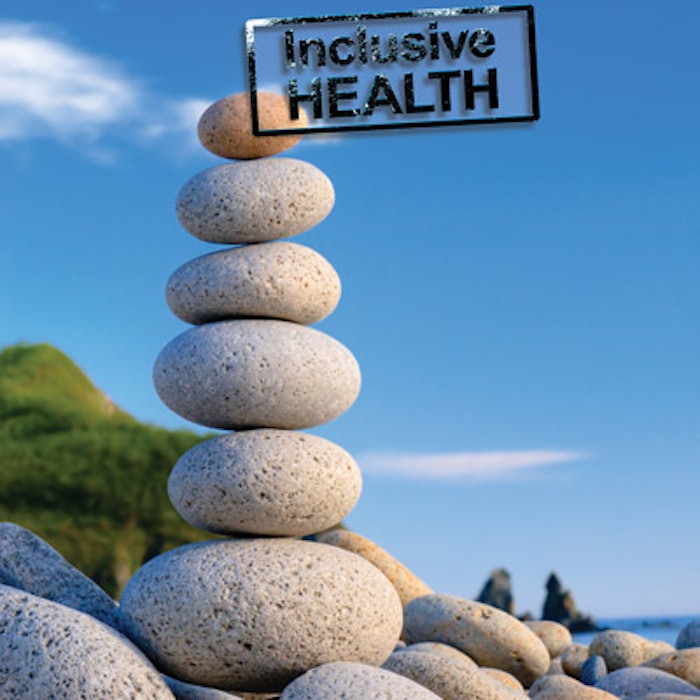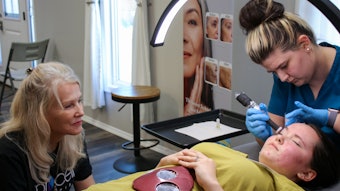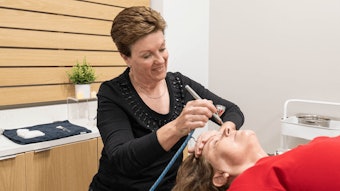
It’s human nature to re-evaluate the way things are done. Consider fashion, food and design. These industries are constantly evolving, borrowing from what’s been done in the past, and improving methods and products for the future. It’s no different in the spa industry, where, before there were AHAs, the basic facial included just the minimum steps. It’s true that American spas got their start with methods and products from Europe; however, the changing landscape of the country, the entrepreneurship of U.S. business and the ingenuity of today’s scientific researchers have pulled the skin care and spa industry in a very different direction than from where it began. What’s certain is that where it is today will likely evolve in the years to come.
Today’s spas are largely unrecognizable from those in the 1980s. The American spa has gone from an exclusive venue where treatments were more pampering than purposeful, to an inclusive one where treatments are custom-designed and therapeutic. Along the way, therapies have come and gone, and come again—sometimes tweaked, sometimes renamed. An explosion in the number of medical spas has also been witnessed. With this, many have asked whether the holistic approach has disappeared. The answer, simply, is no—it has just evolved into an advanced, inclusive health care approach that will be the wave of the future in U.S. day spas, medical spas and medical facilities.
Where did it start?
To understand the inclusive health care approach, step back and see the pattern by which the industry has evolved. The pampering spa of the 1980s was an imported model from Europe. Treatments used French, German or Italian cosmetics, methods were less therapeutic, and the exclusive environment catered to the wealthy. Fast-forward to the 1990s—U.S. spas became holistic centers. Many owners decided to strike out on their own to venture down a path rarely taken in the Western world. The holistic movement argued that long-term solutions could never be achieved without finding and treating a root cause. This movement was in defiance of the medical world, which has its therapies based more on systemic drug therapy. Thus, there was a gradual progression down the well-being path in the 1990s—a path replete with alternative therapies and saturated with Asian philosophies.
All the while, a large portion of the industry remained ever-focused on medical esthetics. Slowly, acceptance of the spa environment and esthetic practitioners occurred in the medical world. Physicians began partnering with estheticians and body work professionals to augment waning revenues, which the decrepit U.S. health care system helped shrink. But adding skin care and holistic services to their invoices did more than just pad revenues. Clients and patients were asking for more and experiencing real results. The spa environment offered the caring service so absent from traditional medical care and holistic treatments from the alternative world and the Far East satisfied the growing natural movement. As a result of these trends, which overlapped and intermingled, the skin care and spa industry gave birth to its newest creation: the medical spa.
What changed?
Through their partnerships with spa professionals, aesthetic physicians in medical spas were introduced to a multidisciplinary strategy of treatment where each professional worked toward wellness, within the confines of their respective specialties. Often, the protocols were under the direction of a physician and—although aimed at being therapeutic—in many cases, the combinations were heavy on the medical focus. In addition, there was a lack of synergy across specialties and the left hand didn’t know what the right hand was doing. Packages were a mishmash of therapies that sometimes made no sense or could be counterproductive to the patient’s goals. Some overbearing physicians caused resentment among medical spa staff members who felt there should be more of a partnership—or yin and yang—when treating patients. All of this started to change as time went on. A shift in the physician-dominated spa model began to occur because consumers demanded less invasive or noninvasive medical procedures.
Moving away from invasive procedures resulted in an increase in the collaboration between specialties, and new systems and protocols that integrated other fields were discovered. The physician’s leading role became diluted and, at the same time, the practice of integrative medicine proved to be incomplete. Fundamentally, integrative medicine could not work. It is flawed because it allows for only some therapies to be included. Integrated modes of treatment were often secondary to, and not as good as, primary medical care. As such, there still remained a great disconnect among health care and spa professionals, as well as the very patients and clients they treated.
What is inclusive health?
To address the across-the-board disconnect, an inclusive system of care had to be introduced to U.S. spas. Now practiced in some medical spa facilities throughout the nation, inclusive health care involves a team of professionals who partner with the patient to achieve long-lasting cosmetic goals and total wellness.
After a thorough examination of a patient’s health—internally, externally and emotionally—a mutually agreed-upon goal is discussed with the patient and a treatment protocol is outlined using input from all medical spa staff members, which could include physicians, lifestyle practitioners, estheticians and body workers, to name a few. Each participant, including the patient, shares an equal responsibility in achieving the common goals. For organization’s sake, inclusive health programs are subdivided into categories, such as external care—facials, skin care, cosmetic surgery; internal care—nutrition, supplements, medication; and emotional care— relaxation spa services, stress-reduction, psychoanalysis, support groups.
Take, for example, a patient with severe acne. In an inclusive health care environment, the treatment would begin with a thorough physical and clinical evaluation including lab tests to reveal lifestyle, nutrition, stress levels, hormonal balance and blood composition. From there,
- an esthetician might begin enzyme facials and assign a home care regimen to complement in-house procedures;
- a physician could then address acne-scarring with medical solutions, if needed;
- a nutritionist could administer a recommended immunity-boosting diet and supplement program to fortify cellular health and healing;
- a massage therapist could offer body services to reduce stress;
- a psychiatrist or support group may help with the mentally debilitating aspect of acne and acne-scarring;
- a makeup artist could offer makeup application tips for covering up blemishes as they heal; and
- if the acne is related to a medical issue such as polycystic ovarian syndrome and excess weight is an issue, exercise physiology professionals may assist in weight loss goals, while an endocrinologist could prescribe the appropriate care for any concomitant, underlying medical issues.
Scientific study has brought the industry to where it is today, and consumers have pushed it to honor their requests for better and longer-lasting results. As more has been learned about the human body and mind, a full story has begun to appear, but there is still much to discover. A great deal has been learned, down to the body’s miniscule cellular components. What these tiny parts reveal is that everything is connected, from what is felt to what is eaten, lifestyles, sleeping habits … all body parts, including muscles, blood vessels and connective tissue rely on each other; all organs are connected, and all cells work together. Making changes in internal health and emotional composition, in addition to therapeutic esthetics, produces profound results internally and externally.
Today’s inclusive health care environment aims at being noninvasive, goes beyond the holistic approach and includes nutrition, hormone therapy, exercise physiology and psychological health in addition to medical treatments, spa services and therapeutic skin care. Collectively, the result is optimum health and beauty that lasts.
A comparison
Inclusive health is truly an American creation with roots in European and Asian philosophies. Although international concepts have been imported to the U.S. spa industry, they’ve also been adapted for the needs and demands of American clientele. Interestingly, Europe is now looking at the United States for cues about how to become more relevant to European consumers. European spas have historically been based on treatments that use natural resources and incorporate some medical care, but not to the extent of being whole-health, inclusive care centers, such as those currently found in the United States. Although European spas have traditionally focused on a comprehensive approach to therapeutic stays that may last for weeks,1 the newest trend is to offer shorter day-long packages that provide the cosmetic aspect of inclusive care. All things considered, there are still many differences between American and foreign spas.
The biggest difference between U.S. spas and those in Europe—other than the lax attitude toward nudity—is water therapies and the use of oils. Water services still remain a tough sell in most American spas and are largely absent in medical spas. In the United States, water does not form the foundation for all other treatments as it does overseas. Oils are generally not used as often in the United States either, because Americans are broadly opposed to greasy-feeling skin.
Long ago in Europe, health, wellness and beauty surrounded the use of balneotherapy, or medicinal bathing, including drinking natural spring water. It is to this day in Europe widely acknowledged that water therapies have a noticeable effect on motor skills, skin, mental health and other conditions.2 As such, water features are much more elaborate in Europe and form the core of a spa-goer’s therapies. For example, in France—the birthplace of thalassotherapy—bathing in sea minerals is believed to keep infection at bay, promote pain relief, assist in the rejuvenation of skin cells, and promote a healthy exchange of minerals and toxins between the blood and water.3
But things are beginning to merge. For example in Germany, in addition to skin care treatments, there are spa treatments for cardiovascular disease, musculoskeletal illnesses, rheumatic diseases, gynecological problems, disorders of the nervous system, psychosomatic fatigue, general infirmity and convalescence.4
Similarly in Russia clients undergo a medical evaluation and receive prescriptions if needed, as well as a treatment schedule of walks and massages for relaxation and health benefits. However, during an average three-week stay at a Russian spa, days are still structured around meals and mineral waters, be it drinking them or bathing in them.5
In Italy, where spa visits date back to ancient Rome, today’s services have evolved with the inclusive approach. Interestingly, the fastest-growing area in Italian spas is anti-aging and cosmetic procedures.6 A spa stay may include a guest evaluation that focuses on biological age, and everything from health history to emotional countenance, stress levels, memory, skin and body composition and flexibility. A team of experts then outlines a list of mind and body health services, in addition to external treatments including microdermabrasion, massage, filler injections, mud therapy and bathing with vegetable, mineral or marine extracts.
Total care
Like the overseas spa industries, the face of the U.S. spa market is continually changing. A look back offers a glimpse of just how much. Holistic practices are not dead. Along with countless other therapies and methods, they have simply been reborn as inclusive health care, a revolutionary strategy that will ultimately help make people as healthy as possible, both inside and out. Inclusive health care can foster wellness, encourage skin health and thwart aging on every front—externally, internally and emotionally. In this new era of the skin and spa industry, health and beauty in the United States have become synonymous. Taking notes from the industry’s successes, it’s ironic that spas overseas—from which professionals derive their foundation—are now looking to America for the next thing: spa protocols to treat the mind, skin, body and spirit—inclusively.
REFERENCES
1. www.visiteuropeanspas.com/european-spa-industry (Accessed Jan 21, 2009)
2. P Hill and L Todd, Advanced Face and Body Treatments for the Spa, Delmar: Clifton Park, NY (2008) 3–5
3. www.skininc.com/spabusiness/leaders/spas/20656484.html (Accessed Jan 21, 2009).
4. www.germany-tourism.de/ENG/nature_active_recreation/health_resorts_spas_tlkur-id1039.htm?cc_lang= (Accessed Jan 21, 2008)
5. www.russianlife.com/article.cfm?Number=1645 (Accessed Jan 21, 2009)
6. www.forbes.com/2008/09/08/top-europe-spas-forbeslife-cx_ls_0908travel.html (Accessed Jan 21, 2009)
GENERAL REFERENCES
H Murad, The Cellulite Solution, St. Martin’s Press: New York (2005)
H Murad, Wrinkle-Free Forever, St. Martin’s Griffin: New York (2003)
H Murad, Integrating Medicine and Esthetics, Skin Inc. magazine 10(6) 19–22 (August 1998)
H Murad and D Lange, The Murad Method, Macmillan: New York (2003)










